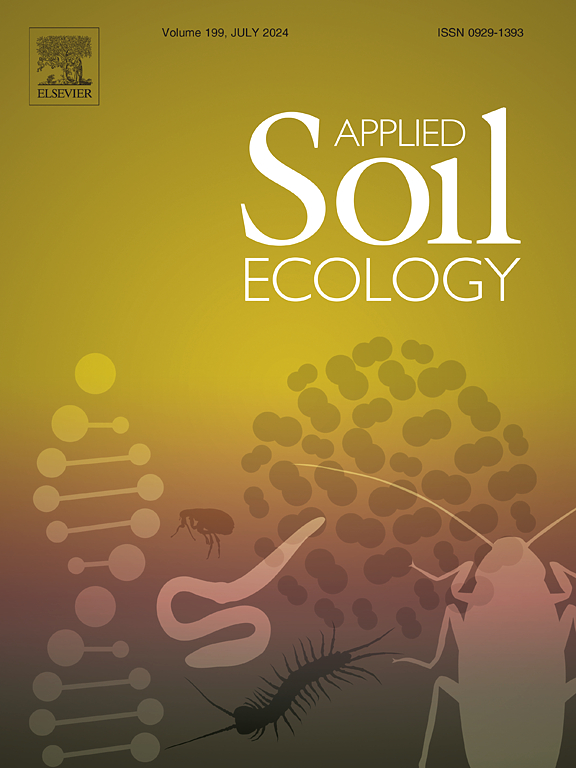羽扇豆与大麦间作:根与根之间的相互作用驱动氮素从豆科植物向谷类作物的转移
IF 5
2区 农林科学
Q1 SOIL SCIENCE
引用次数: 0
摘要
谷物和豆类间作是减少农业肥料投入的一种手段。谷物-豆科作物间作中经常发生生物固定氮的转移,本研究旨在了解其背后的机制。羽扇豆因其高蛋白含量和有效的土壤磷提取而成为农艺学上的重要豆类。然而,由于羽扇豆素通常被描述为非菌根,氮从羽扇豆到大麦的转移途径仍有待阐明。我们研究了间作羽扇豆素的大麦的生长和营养含量,以测试共生固定氮是否会从羽扇豆素转移到大麦,并重点研究了丛枝菌根真菌(AM)在这种转移中的作用。卢平和大麦种植在盆栽中(作为单一作物或间作)±网眼围栏,限制隔间之间菌丝和/或根的生长。记录植物生长和AM真菌根定植情况,测定植株15N自然丰度,确定固定N从卢平向大麦转移的潜在途径。间作处理显著提高了大麦的生长和氮含量,在两种作物根际杂交的情况下效果最为显著。此外,植物中15N的天然丰度证实了N从羽扇豆向大麦的转移。由于露平根仍然是非菌根,即使存在菌根供体植物,菌丝N的易位也不太可能。我们得出结论,从非菌根羽扇豆到菌根大麦的氮转移主要是通过大流量进行的,这是由种间根与根接触刺激的。这可能有助于黑豆与大麦间作的成功。本文章由计算机程序翻译,如有差异,请以英文原文为准。
Lupin-barley intercropping: Root to root interactions drive nitrogen transfer from legume to cereal
Intercropping cereals and legumes is a means to reduce fertilizer input in agriculture. Transfer of biologically fixed N often occurs in cereal-legume intercropping and this study aims to understand the mechanism behind. Lupins are legumes of agronomical interest due to their high protein content and effective soil P extraction. However, as lupins are commonly described as non-mycorrhizal the transfer route of N from lupin to barley remains to be elucidated. We investigated the growth and nutrient content of barley intercropped with lupins, to test whether transfer of symbiotically fixed N from lupins to barley occurs, with focus on any role of arbuscular mycorrhizal (AM) fungi in this transfer.
Lupin species and barley were grown in pots (as sole crop or intercropped) ± mesh enclosures restricting mycelial and/or root growth between compartments. Plant growth and AM fungal root colonization were recorded, and plant 15N natural abundance was measured to determine potential transfer routes of fixed N from lupin to barley.
Intercropped treatments showed increased barley growth and N contents, most pronounced if root-root intermingling of the two species was allowed. Also, 15N natural abundance in plants corroborated N transfer from lupins to barley. As lupin roots remained non-mycorrhizal, even in presence of a mycorrhizal donor plant, hyphal translocation of N was unlikely.
We conclude that N transfer from non-mycorrhizal lupins to mycorrhizal barley primarily occurred through bulk flow, stimulated by interspecific root-to-root contact. This may contribute to the success of lupin and barley intercropping.
求助全文
通过发布文献求助,成功后即可免费获取论文全文。
去求助
来源期刊

Applied Soil Ecology
农林科学-土壤科学
CiteScore
9.70
自引率
4.20%
发文量
363
审稿时长
5.3 months
期刊介绍:
Applied Soil Ecology addresses the role of soil organisms and their interactions in relation to: sustainability and productivity, nutrient cycling and other soil processes, the maintenance of soil functions, the impact of human activities on soil ecosystems and bio(techno)logical control of soil-inhabiting pests, diseases and weeds.
 求助内容:
求助内容: 应助结果提醒方式:
应助结果提醒方式:


